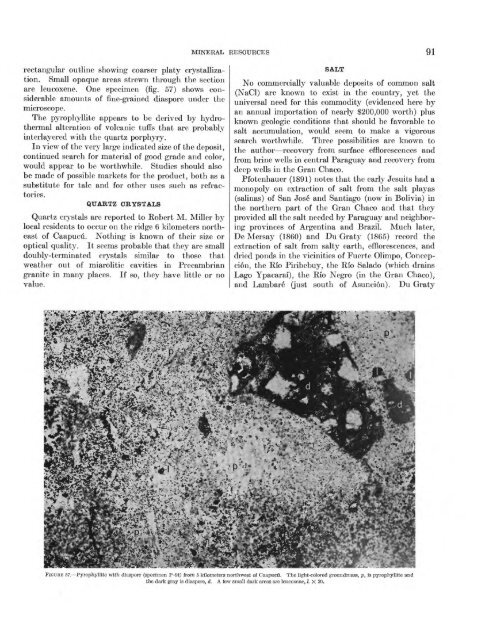Geology and Mineral Resources of Paraguay A Reconnaissance
Geology and Mineral Resources of Paraguay A Reconnaissance
Geology and Mineral Resources of Paraguay A Reconnaissance
- No tags were found...
You also want an ePaper? Increase the reach of your titles
YUMPU automatically turns print PDFs into web optimized ePapers that Google loves.
91rectangular outline showing coarser platy crystallization.Small opaque areas strewn through the sectionare leucoxene. One specimen (fig. 57) shows considerableamounts <strong>of</strong> fine-grained diaspore under themicroscope.The pyrophyllite appears to be derived by hydrothermalalteration <strong>of</strong> volcanic tuffs that are probablyinterlayered with the quartz porphyry.In view <strong>of</strong> the very large indicated size <strong>of</strong> the deposit,continued search for material <strong>of</strong> good grade <strong>and</strong> color,would appear to be worthwhile. Studies should alsobe made <strong>of</strong> possible markets for the product, both as asubstitute for talc <strong>and</strong> for other uses such as refractories.QUARTZ CRYSTALSQuartz crystals are reported to Robert M. Miller bylocal residents to occur on the ridge 6 kilometers northeast<strong>of</strong> Caapucu. Nothing is known <strong>of</strong> their size oroptical quality. It seems probable that they are smalldoubly-terminated crystals similar to those thatweather out <strong>of</strong> miarolitic cavities in Precambriangranite in many places. If so, they have little or novalue.SALTNo commercially valuable deposits <strong>of</strong> common salt(NaCl) are known to exist in the country, yet theuniversal need for this commodity (evidenced here byan annual importation <strong>of</strong> nearly $200,000 worth) plusknown geologic conditions that should be favorable tosalt accumulation, would seem to make a vigoroussearch worthwhile. Three possibilities are known tothe author recovery from surface efflorescences <strong>and</strong>from brine wells in central <strong>Paraguay</strong> <strong>and</strong> recovery fromdeep wells in the Gran Chaco.Pfotenhauer (1891) notes that the early Jesuits had amonopoly on extraction <strong>of</strong> salt from the salt playas(salinas) <strong>of</strong> San Jose <strong>and</strong> Santiago (now in Bolivia) inthe northern part <strong>of</strong> the Gran Chaco <strong>and</strong> that theyprovided all the salt needed by <strong>Paraguay</strong> <strong>and</strong> neighboring provinces <strong>of</strong> Argentina <strong>and</strong> Brazil. Much later,De Mersay (1860) <strong>and</strong> Du Graty (1865) record theextraction <strong>of</strong> salt from salty earth, efflorescences, <strong>and</strong>dried ponds in the vicinities <strong>of</strong> Fuerte Olimpo, Concepcion,the Rio Piribebuy, the Rio Salado (which drainsLago Ypacarai), the Rio Negro (in the Gran Chaco),<strong>and</strong> Lambare (just south <strong>of</strong> Asuncion). Du Graty^mffFIGURE 57. Pyrophyllite with diaspore (specimen P-91) from 5 kilometers northwest <strong>of</strong> Caapucfl. The light-colored groundmass, p, is pyrophyllite <strong>and</strong>the dark gray is diaspore, d. A few small dark areas are leucoxene, I. X 20,
















